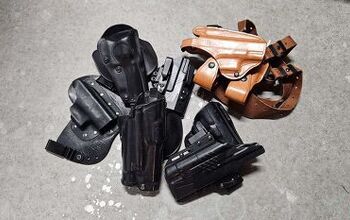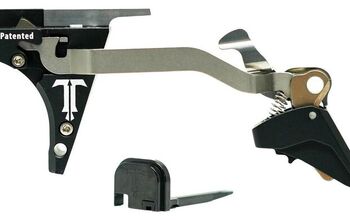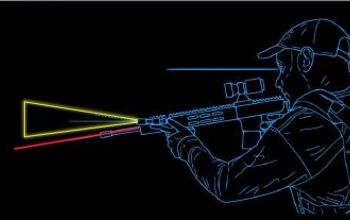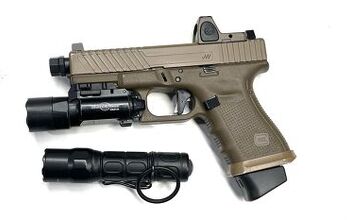Vietnam's Converted Submachine Gun, The K-50M

When most people think of the Vietnam War and the weapons used by the North Vietnamese forces, iconic firearms like the AK-47 or the SKS usually come to mind. But there's one lesser-known weapon that played a key role during the conflict: Vietnam’s very own submachine gun, the K-50M. The K-50M is a curious piece of Cold War-era hardware that’s part Chinese, part Vietnamese, and totally underrated.
Born in the Shadows of the PPSh-41
To understand the K-50M, you’ve got to go back to World War II. One of the Soviet Union’s most iconic weapons of the era was the PPSh-41, a high-capacity, rapid-fire submachine gun. Its compact size and high rate of fire made it ideal for urban warfare and close-quarters combat, allowing Soviet troops to unleash a high volume of fire with devastating efficiency. The PPSh-41 was durable, easy to make, and deadly in close-quarters combat. It quickly became a favorite among Soviet soldiers and later second-hand users.
Fast-forward to the 1950s and 60s: The Soviet Union was supplying its communist allies with weapons, including the PPSh-41. China also received the tooling and started production of its own version in 1950, called the Type 50. North Vietnam received many of these Chinese Type 50s in military aid to fight the French and then the Americans, but there was a problem. Jungle warfare isn’t exactly kind to bulky, unwieldy firearms, and the PPSh, designed for European battlefields, wasn’t a great fit for Southeast Asia's humid, close-in terrain. And the stature of the soldiers required some changes.
Made in Vietnam
That’s where the K-50M comes in. It was essentially a Vietnamese reworking of the PPSh-41 and a French MAT-49 inspired stock, produced by the Z1 factory in the north and reportedly started in 1962. Vietnamese gunsmiths made a weapon that better suited their unique needs using the Chinese Type 50s as the base, which were themselves clones of the PPSh-41.
The lower receiver was made in Vietnam. Two pieces of sheet metal were spot-welded together, and the two-position stock assembly was attached to the lower. It was inspired by the MAT-49, though shorter for Vietnamese soldiers' short stature.
The K-50M wasn’t a completely new design, but it was far from a lazy copy. It is more of a modification with a shortened shroud, which made it handier and lighter to haul around the jungle. With the shortened barrel shroud, a new front sight was added, similar to the Chinese Type 56 rifles, and a Type 56 pistol grip. The wooden stock of the PPSh-41 was replaced with a metal collapsing stock, similar to what you’d find on the French MAT-49. This made it more compact and easier to carry during guerrilla operations and in tunnel systems.
Like the PPSh-41, the K-50M fired the 7.62x25mm Tokarev cartridge, a potent little cartridge known for its high velocity and good penetration. The K-50M fed from a 35-round stick magazine. In terms of range, it was most effective within 50 to 100 meters. Anything past that, and you were pushing the limits of both the cartridge and the open iron sights. But it was brutally effective in close-quarter ambushes or room-to-room fighting, like during the Tet Offensive.
The K-50M was primarily used by the People’s Army of Vietnam (PAVN) and the Viet Cong (VC) guerrilla fighters during the Vietnam War. It wasn’t as widespread as the AK-47 or SKS, but it saw solid use, especially in the early and middle years of the war.
Its compact size made it a favorite for guerrilla fighters, sappers, and rear-guard troops who needed something lightweight and quick to fire. It also popped up in photographs and footage of the war, sometimes confusing U.S. analysts who weren’t sure what this odd, hybrid-looking SMG was.
While the K-50M wasn’t revolutionary in terms of design, it was a great example of practical adaptation. North Vietnamese forces took what they had, an aging Chinese gun, and reshaped it to fit their combat style and terrain. That kind of battlefield ingenuity is a big reason why they were able to hold their own against much better-funded and technologically superior forces.
Also, the K-50M showed that effective small arms don’t always have to be high-tech. Sometimes, adding a new lower and welding on a folding stock is all it takes to make a weapon that works for your specific environment.
The K-50M Today
After the Vietnam War, the K-50M faded into obscurity. It’s rarely seen outside of museums, collector circles, or old war documentaries. It’s mostly a historical relic in Vietnam, a reminder of the past's resourcefulness.
Still, for military history buffs and gun nerds, the K-50M is a fascinating little weapon. It tells a story not just about firepower, but about adaptation, necessity, and local innovation in the face of overwhelming odds.
Final Thoughts
The K-50M may never get the same spotlight as the AK-47 or the M16, but it deserves a little spotlight. It’s scrappy, reliable, and built for the fight it was meant to win. It’s interesting to see a humble, domestically modified weapon fielded with an estimated 10,000 produced in a war full of high-level politics and superpower rivalry. Having built a K-50M from a Vietnam bring-back kit and test-fired it, the rate of fire at 900 RPM was way too high to be practical. Semi-automatic is the way to go unless you have a lot of magazines and have good control, because the muzzle climb is no joke.
Who knows, maybe one day it’ll get the same love that other Cold War-era firearms enjoy. Until then, it’ll remain a quiet legend of the jungle.

Lynndon Schooler is an open-source weapons intelligence professional with a background as an infantryman in the US Army. His experience includes working as a gunsmith and production manager in firearm manufacturing, as well as serving as an armorer, consultant, and instructor in nonstandard weapons. His articles have been published in Small Arms Review and the Small Arms Defence Journal. https://www.instagram.com/lynndons
More by Lynndon Schooler


























Comments
Join the conversation
Never saw one, and trust me, I saw a lot of strange weapons in 68 and 69 MAT 49, PPSH41, PPS 43, etc. but not that one. I'm guessing they weren't that common.